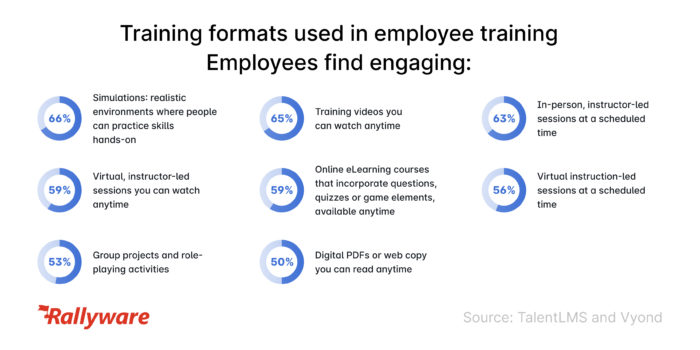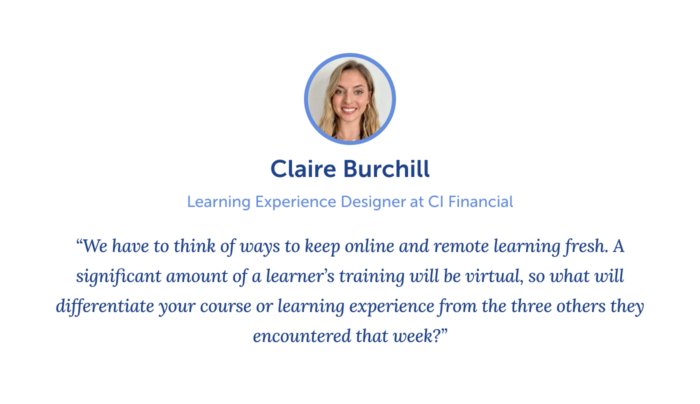Workforce Development Training: Your Guide to Sales Training Content Development in 2024
They say that variety is the spice of life. This principle holds true in many aspects of life, including food, books, music, and, within the context of workforce development training, sales training content.
Training is key, and this is especially so in today’s ever-evolving landscape of work. As research from TalentLMS and Vyond found, 41% of employees will search for another job in 2024 if their company doesn’t provide them with training opportunities. Indeed, for sales enablement and L&D leaders, content diversity is king. Here, we break down why content diversity matters, along with some tips for designing the ultimate training strategy for your workforce.
Why Training Content Diversity Matters for Frontline Engagement
Carving out more time in the day
Time is a big barrier for many. For sales associates who work in a store with numerous brands, finding time for training on each one can be challenging. Conversely, do brands and operations leaders have the time to generate multiple documents and brochures? Not likely. This is why content that is short and snappy, yet comprehensive and informative, is the optimal approach. In fast-moving industries such as retail, information is moving quickly, and engaging training content matters.
Catering to different audiences and learning styles
People learn at their own pace, and have their preferred learning styles. If training is overly complex or cumbersome, you run the risk of alienating some, who may struggle or fail to complete it. Lengthy text and text-heavy slides may lead to a lack of engagement among associates, and diminish the effectiveness of the learning program.
Making incentives programs count
Training is also important in terms of incentives and recognition programs (complete this brand training quiz for a chance to win a pair of ski boots)! By connecting incentives to specific behaviors, such as completing training modules, you can encourage employees to repeat these actions to boost their productivity. To do this effectively, you need training content that sparks engagement and gets retained.
6 Questions to Consider when Designing a Workforce Development Training Strategy
Do you overemphasize longform content?
There are generational differences to keep in mind, in terms of technology adoption, communication preferences and workplace expectations. For instance, younger generations, such as millennials and Gen Z, have grown up in a digital area and are more adept at using technology.
Consider TikTok – the widely popular video sharing platform who’s videos exemplify the concept of microlearning (content that is presented in small, digestible pieces rather than lengthy chunks). TikTok has become a favored platform for teachers, as a way to connect with students where they are. And it is important to ensure that your content can compete with interactive social media. If content is difficult to access and feels dated, associates won’t want to complete it during their downtime. You want to be producing content that’s just as effective at capturing attention as TikTok videos. (Part of that, of course, is establishing incentives for completing content, which is a separate topic).
Beyond education and entertainment, research from Adobe found that over 2 in 5 Americans use TikTok as a search engine, while nearly 1 in 10 Gen Zers are more likely to rely on TikTok than Google as a search engine. According to survey respondents, TikTok is attractive because it features short and instructional videos, a distinct storytelling format, and personalized content tailored to the viewer.
Do you have a mixture of different mediums through which training content is delivered (i.e. video, text, visuals)?
Content doesn’t necessarily need to be delivered via formal slideshows or training manuals – or even lengthy videos, as in some brand training content for retail associates. Sometimes, the more personable the approach, the better. TalentLMS and Vyond’s report also found that over 7 in 10 employees remember information presented in a video better than information presented in writing. But other learners might have different styles and prefer visual or written formats. It’s important to employ training content delivery methods – that is, technologies – that can adapt and personalize the content an associate receives on a daily or semi-daily basis.
So, mix up the mediums! Consider creating a training deck heavy on visuals (like GIFs), or a podcast-style training module for employees to listen to while on-the-go. For video content, Rallyware’s product and sales training experts typically suggest a duration of 2-3 minutes.

Do you have a mixture of different content styles (i.e. casual, educational lessons, humor for engagement)?
As we saw from TikTok, many are drawn to the platform for its storytelling aspect. Additionally, 76% say that humor helps them remember more of the training content. Incorporate different content styles to keep things interesting! The way you say things is as important as how you say them. And again, it is essential to not only have a mix of content, but product training technology that actively personalizes content delivery based on the associate’s preferences and past activities.
Do you have a platform that supports multiple formats?
When considering new content styles and mediums, it is important to have a platform that can accommodate them, as well as intelligently and flexibly personalizing the right content. Rallyware’s performance enablement platform supports multiple content formats, with real-time image and video recording.
For instance, Rallyware enables Fleet Feet’s Education Manager Heather Fencik to train at a massive scale, both geographically and chronologically. If she conducts remote training for a live audience, she can record this session and store it on the platform for employees to easily watch on their own time. “We see significant engagement with rewatches. It gives flexibility to folks who might not be able to make the training because of their work schedule or their time zone, and scalability to us,” Heather said.
The concept of ‘on-demand training’ is a vital one, as associates should not have to wait until another training session is offered. Training should be continuous – it should not only be knowledge development, but sales-skill development.
A performance enablement platform such as Rallyware’s helps associates easily upskill with on-demand training to boost product knowledge, customer service, and sales capability. Training that is delivered on-demand and in the flow of work – such as a retail sales associate reviewing a new feature of a product prior to interacting with a customer – can be much more effective.

Do you have personalization on your radar?
As veteran learning development consultant Jonathan Halls stressed, learning takes time. “But we can increase efficiency by personalizing the content and learning experience as well as weeding out redundancy,” he said.
Taking a hyper-targeted approach, Rallyware adapts to individual learning styles. Product knowledge and sales training are repeatedly reinforced and personalized for each member of the sales force utilizing their performance data.
As an example, Carol faces challenges in connecting with new customers. Given her English degree, she has a preference for reading, so the platform intelligently comes to understand that she works best with text-based content. Thus, it assigns her textual resources with tips to assist her in building new relationships. This training will be reinforced, so every so often she will be delivered a little nudge to encourage her to keep learning and developing her skills in this area, with a new training note to read and then implement in-store.
Do you gather insights from your training and make adjustments accordingly?
After the training has been delivered, how can you assess its impact? Perhaps you need to retweak your strategy, and having a platform that enables you to do this is key. With Rallyware, for instance, brands can access brand advocacy data to see how confident sales associates feel in their product knowledge, and then act on this by sending more targeted and engaging training content to those who feel less confident. Who are your brand champions? How do you enable them for more success, engagement, and confidence – so that they turn other associates into champions as well?
With the right platform, you can also get some signals into the effectiveness of your training content. If a video is too long, this may be reflected in negative comments and ratings from employees, a strong sign that content may not be resonating. Adopt a user-centric approach by actively listening to associates and how they perceive the training. Just ensure that your training technology has flexible and easy-to-use tools for user feedback, like Rallyware does.
Tips for Workforce Development Training in 2024
What is the ideal frontline sales training format? The answer is that it depends on various factors, and it is best to cast a wider net and adopt a comprehensive approach to appeal to different learners. Rethink lengthy training sessions, monotonous delivery or a universal approach and embrace diversity in training content. Take inspiration from popular, interactive platforms such as TikTok! By incorporating some of the tips above, you will be able to deliver captivating training experiences that excite, engage, and make an impact.
Schedule your demo to see Rallyware in action, and how the platform can help you deliver targeted frontline sales training content that matters!
News and Insights on Workforce Training & Engagement
We’re among top-notch eLearning and business engagement platforms recognized for effective training and talent development, helping to empower distributed workforces
Subscribe
